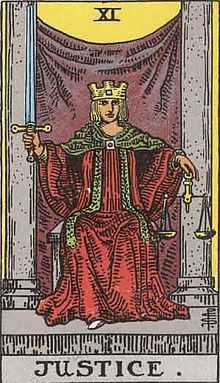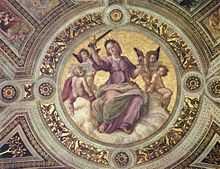Justice (Tarot card)

Justice is a Major Arcana Tarot card, numbered either VIII or XI, depending on the deck. This card is used in game playing as well as in divination.
Description
The Justice card, as a member of the Tarot deck, appears in early Tarot, such as the Tarot de Marseilles. It is part of the Tarot's major arcana, and usually follows the Chariot, as card VIII, although various decks vary from this pattern. Justice (virtue), accompanies two of the other cardinal virtues in the Major Arcana: temperance and strength.
A. E. Waite was a key figure in the development of the most famous of modern Tarot interpretations.[1] His version of the Justice card contains, as his cards usually do, references to classical Mythology. In his deck, the card is 11 (switched with the Strength (Tarot card)).
Some frequent keywords include:
- Impartiality — Distance — Coldness — Justice
- Objective mind — Criticism — Being clever — Insensitivity
- Decision — Intellect — Analysis — Stillness — Curiosity
- Responsibility — Rationality — Clear vision — Logic and reason
Mythopoetic approach
Justice, in many Tarot representations, is attributed to Athena.
Athena was the patron goddess of Athens, credited with bringing not merely the idea of justice, but a model for justice, to Athens, Greece. Embedded in many versions of this card is the story of the cursed House of Atreus. Atreus broke a promise to Artemis, who in turn cursed his family, which was a house or lineage descended from Pelops and from Tantalus, who had fed his own son to the gods at a dinner party.
The story culminates with an episode involving Agamemnon, a hero of the Trojan War. Agamemnon was not always heroic, at least in modern eyes. He sacrificed his own daughter, Iphigeneia, to get a favorable wind to Troy. In vengeance for this unfatherly act, his wife, Clytemnestra, mother of Iphigeneia, orchestrated his murder. Their son, Orestes, in turn sought vengeance for the death of his father by killing his mother. He was then pursued around the world by The Furies, who avenged mothers killed by sons.
Athena then called an end to the cycle of vengeance and empaneled the first jury.
Justice mediates the various claims of right, of morality, of duty. In a world of scarcity, not every claim can be met. Justice, in theory, sets forth a system to judge between the claims. The tarot card is therefore typically closer to the notion of Jurisprudence than to the abstract concept of Justice.
The Justice card is closely connected to The High Priestess through its cross sum (the sum of the digits). Unlike the hidden knowledge of the High Priestess, Justice is decided in the open; we are left hoping that our intellect and our intuition take us to the same place.
Justice is also connected to Judgment, Key 20, the ultimate weighting of souls.
Maàt was a goddess of justice in Egypt. She ties Judgment with Justice, as she helped judge the souls of the dead. Therefore, on many Tarot cards of Justice, Maat appears.
The notion of Justice is older than Athena, of course, even among the Greeks. Themis, a Titan, lurks in the archetype too. She was a goddess of natural order, and judged souls after death. She is the intersection of the Sacred and Secular orders. Themis was the mother of The Fates, who must be accommodated.
Plato said that Athena came from Africa, and if that is so, it is likely that Athena’s origins lie in the Egyptian goddess Neith. Like Athena, Neith was a goddess of war and weaving, associating the card with the tangle of ordered threads that make up the fabric of communal life. Neith was also, in some stories, the mother of Ra, making her an avatar of the Mother Goddess who is the womb and tomb of the Sun. In Native American tarot decks, this card is sometimes associated with Spider Grandmother.[2]
Justice is also associated with the 11th card of the Minor Arcana, The Pages (at least in Waite and Ryder-Waite, who assigns Justice the number eleven). Pages represent the beginning of a journey. Justice is a necessary, but not sufficient, step in becoming fully human. It can be seen as a beginning.
While Athena usually upholds the existing order, demanding that everyone receive their due as defined by the current order, she is also the older sister of her brother. This is significant because the second child of Metis is fated to overthrow Zeus (The Emperor). Zeus ate Metis to prevent her from bearing this second child, but there are those who say he awaits the call, and that Athena may take up his mantel if he is never born. Then, Justice may overthrow Power.
When Justice appears in a throw, it usually signals that some injustice needs righting, that something in the world is dangerously out of balance. This could be interior to the Querent (not giving the self its due; arrogance), or it could be the calling of the Querent (to right some external wrong). It is important, however, that the Querent be aware that most things in the exterior world that they perceive (at least as mediated by a tarot throw) are in fact an externalization of some interior process or conflict.
Justice Reversed is the classic signal of life out of balance.
In Waite's classic version, to the right are represented the scales (Libra), signifying balance; to the left is the sword, signifying accountability.
Numbering
Justice is traditionally the eighth card and Strength the eleventh, but the influential Rider-Waite-Smith deck switched the position of these two cards in order to make them better fit the astrological correspondences worked out by the Hermetic Order of the Golden Dawn, under which the eighth card is associated with Leo and the eleventh with Libra. Today many decks use this numbering, particularly in the English-speaking world. Both placements are considered valid.
In popular culture
- Justice is also the name of the first boss in The House of the Dead 4, It also serves as the first boss in The House of the Dead 4 Special. It is depicted as a giant four-armed humanoid zombie with a razor sharp tongue. Justice continues the House of the Dead series's tradition of naming its bosses after the Major Arcana of Tarot.
- In the SNES video game Ogre Battle: The March of the Black Queen, the Justice Tarot card is labeled as XI, and depicts a long-haired knight standing up, holding a sword in his right hand and scales in his left hand. On drawing the card after liberation of one of the towns, it increases the characters' maximum HP by 1 point, and summons a blizzard to attack enemy units when used in battle.[3]
References
- ↑ Wood, 1998
- ↑ Harry Sparrowhawk in Gonzalez and Weck. Native American Tarot. 1989.
- ↑ "Ogre Battle - Tarot Cards". Fantasyanime.com. Retrieved 2013-03-28.
- A. E. Waite's 1910 Pictorial Key to the Tarot
- Hajo Banzhaf, Tarot and the Journey of the Hero (2000)
- Most works by Joseph Campbell
- G. Ronald Murphy, S.J., The Owl, The Raven, and The Dove: Religious Meaning of the Grimm's Magic Fairy Tales (2000)
- Riane Eisler, The Chalice and the Blade (1987)
- Mary Greer, The Women of the Golden Dawn
- Merlin Stone, When God Was A Woman
- Robert Graves, Greek Mythology
- Juliette Wood, Folklore 109 (1998):15-24, The Celtic Tarot and the Secret Tradition: A Study in Modern Legend Making (1998)
External links
| Wikimedia Commons has media related to Justice (Tarot). |
| ||||||||||||||||||||||||||||||||||||||||||||||||||
This article incorporates text from the public domain 1910 book Pictorial Key to the Tarot by Arthur Edward Waite. Please feel free to update the text.
